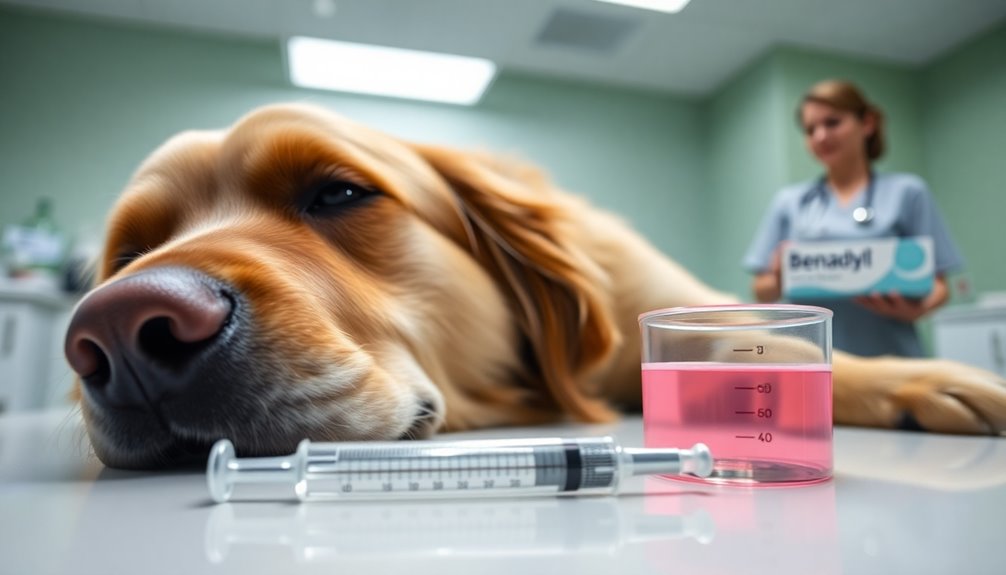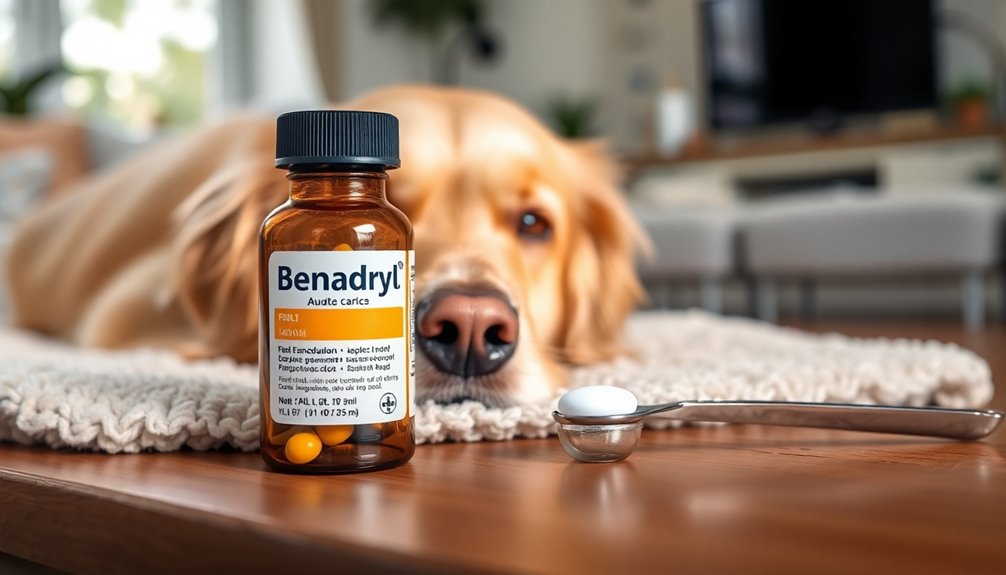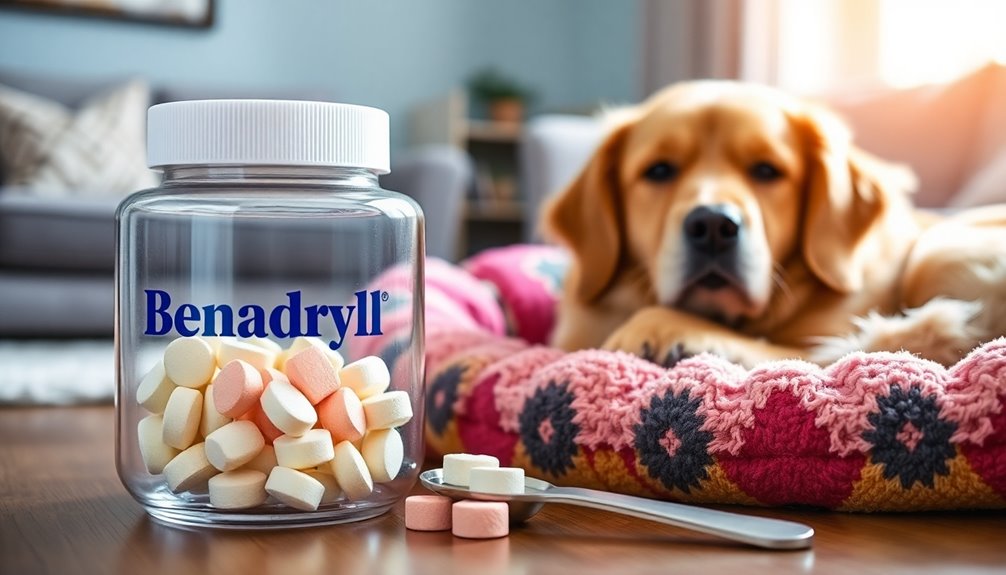When it comes to giving Benadryl to your dog, the safe dosage is about 1 mg per pound of body weight, taken 2-3 times daily. For example, a 10-pound dog should get 10 mg. Remember, while Benadryl helps with allergies and nausea, it isn't FDA-approved for dogs, so consulting your veterinarian is crucial before starting treatment, especially if your dog has health issues. Watch for side effects like drowsiness or dry mouth, and monitor your pet after administering. There's a lot more to evaluate to guarantee your dog's safety and comfort before using Benadryl.
Key Takeaways
- The general dosage of Benadryl for dogs is 1 mg per pound of body weight, administered 2-3 times daily.
- For precise dosing, a 10 lb dog requires 10 mg, while a 50 lb dog needs 50 mg.
- Always consult a veterinarian before administering Benadryl, especially for dogs with underlying health conditions.
- Monitor your dog for side effects such as drowsiness, dry mouth, or any allergic reactions after administration.
- Use liquid forms at a dosage of 1 ml per 2.5 lbs of body weight for accurate measurement.
Overview of Benadryl

Benadryl, also known as diphenhydramine, is a first-generation antihistamine that can be a helpful tool for managing mild allergic reactions and nausea in dogs.
It works by blocking H-1 receptors, preventing histamine reactions that cause symptoms like itching, sneezing, and swelling.
While generally safe for dogs, it's vital to administer Benadryl only under veterinary guidance.
The recommended dosage is typically 2–4 milligrams per kilogram of body weight, given 2-3 times daily based on your dog's individual needs.
Since Benadryl isn't FDA-approved for veterinary use, you must consult your vet before starting treatment.
Proper dosage is important to avoid any adverse reactions, so always prioritize your dog's health and safety when considering Benadryl.
Uses for Dogs

Benadryl can be a helpful remedy for your dog if they're dealing with allergies or itching from environmental irritants.
It's also effective in preventing motion sickness, making car rides more comfortable for your furry friend.
Always check with your vet to verify it's the right choice for your dog's needs.
Allergies and Itching Relief
When your dog experiences allergies, finding effective relief can make all the difference in their comfort. Benadryl is commonly used to alleviate symptoms like itching, sneezing, and hives in dogs. It works by blocking histamine reactions that trigger these allergic reactions.
To guarantee safe usage, consider these tips:
- Consult your veterinarian before administering Benadryl, especially if your dog has underlying health issues.
- Follow the recommended dosage of 2 to 4 mg per kg of body weight, given 2-3 times daily.
- Monitor for side effects like drowsiness, dry mouth, or increased thirst.
Additionally, it's important to note that vet-approved recommendations can guide you in managing your dog's allergies effectively.
With proper care, you can help your dog find relief from their allergy symptoms and improve their overall comfort.
Motion Sickness Prevention
For dogs that experience anxiety or nausea during travel, finding an effective solution is key to ensuring a smooth journey. Benadryl can be a safe and effective option for motion sickness prevention.
Here's a simple dosage guide based on your dog's weight:
| Dog's Weight | Benadryl Dose (mg) | Administration Frequency |
|---|---|---|
| 10 lbs | 10 mg | 2-3 times daily |
| 25 lbs | 25 mg | 2-3 times daily |
| 50 lbs | 50 mg | 2-3 times daily |
| 75 lbs | 75 mg | 2-3 times daily |
Always consult with your veterinarian before administering Benadryl. Monitor for side effects, as reactions can vary. Administer about 30 minutes before travel for best results.
Safety and Risks

Administering Benadryl to your dog can be safe and effective, provided you follow the recommended dosage guidelines.
Always consult with your veterinarian before giving Benadryl, especially if your dog has existing health conditions or is on other medications.
Monitoring your dog after administration is essential, as potential side effects of Benadryl may include:
- Drowsiness or sedation
- Dry mouth or nausea
- Increased heart rate or hyperactivity
Be aware that a Benadryl overdose can lead to serious health risks.
Ensuring the correct dosage is important for your dog's safety.
Dosage Guidelines

Knowing the correct dosage of Benadryl for your dog is essential to guarantee their safety and effectiveness of the medication. The general dosage guidelines suggest administering 1 mg of Benadryl per pound of your dog's body weight, 2-3 times daily. Here's a quick reference:
| Dog's Weight (lbs) | Benadryl Dosage (mg) |
|---|---|
| 10 | 10 |
| 25 | 25 |
| 50 | 50 |
| 75 | 75 |
For liquid formulations, use 1 ml for every 2.5 pounds. Always consult your veterinarian to tailor the dosing based on your dog's body weight, health status, and any other medications. Accurate dosing is key in preventing allergic reactions.
Administration Tips

Once you've determined the right dosage of Benadryl for your dog, the next step is verifying it's administered correctly.
Always consult your veterinarian to confirm the dosage is safe for your dog's weight and health.
Here are some tips for effective administration:
- Use a syringe or measuring spoon for liquid formulations to verify accuracy.
- If using tablets, split them carefully to achieve the correct dosage, as they typically come in 25 mg or 50 mg strengths.
- Monitor your dog closely for any side effects or allergic reactions after administering Benadryl.
Common Side Effects

While Benadryl can be effective for treating allergies and other conditions in dogs, it's important to be aware of potential side effects.
Common side effects include drowsiness, which may lead to increased thirst due to dry mouth. Some dogs might also experience nausea and vomiting, particularly if they're sensitive to diphenhydramine.
Keep an eye out for an increased heart rate or rapid breathing, as these can occur as a reaction to the medication. Urinary retention is another possibility, especially in dogs with pre-existing urinary issues.
Always prioritize monitoring your dog for signs of allergic reactions, such as itching, hives, swelling, or difficulty breathing, after administering Benadryl to guarantee their safety and well-being.
Alternatives to Benadryl

If you're looking for alternatives to Benadryl for managing your dog's allergies, there are several options worth considering.
Always consult your veterinarian before trying new antihistamines like cetirizine (Zyrtec) or loratadine (Claritin) to guarantee they're safe for your dog.
Some effective alternatives include:
- Medicated shampoos for skin allergies and itching
- Prescription medications like corticosteroids for chronic conditions
- Behavioral modification programs or anxiety meds for travel-related anxiety
These alternatives can help manage allergies without the potential side effects of Benadryl. Additionally, using eco-friendly materials in your dog's environment can reduce exposure to allergens.
Remember, each dog is unique, so what works for one mightn't work for another.
Always prioritize your dog's health by seeking professional advice.
Frequently Asked Questions
How Much Benadryl 25 Mg Can I Give My Dog?
When you're considering how much Benadryl you can give your dog, remember that the dosage usually depends on their weight.
For dogs around 25 pounds, a single 25 mg tablet is typically fine. If your dog weighs less, you might need to split the tablet to guarantee accurate dosing.
Always keep in mind, it's essential to consult with your vet before giving Benadryl to confirm you're doing it safely and effectively.
Is There a Difference Between Human Benadryl and Dog Benadryl?
When it comes to Benadryl, you're walking a fine line.
Human Benadryl contains diphenhydramine, which can be safe for dogs, but it's not made for them.
You need to steer clear of formulations with extra ingredients like decongestants or alcohol, as those can be harmful.
Always check with your vet before giving your dog anything, even Benadryl, to confirm it's the right choice for their health and weight.
Will Benadryl Help My Dog Itching?
If your dog's itching is due to mild allergies, Benadryl might help.
It works by blocking histamines, which can alleviate those pesky itches caused by pollen or insect bites.
However, it's not guaranteed to be effective for every dog, and some might even feel more anxious after taking it.
Always monitor your pup for side effects like drowsiness or dry mouth, and consult your vet to confirm it's the right choice for your furry friend.
How Much Benadryl Can I Give My Dog Calculator Per?
To determine how much Benadryl you can give your dog, you'll want to calculate the dosage based on their weight.
Generally, it's about 2 to 4 mg per kilogram (or 0.9 to 1.8 mg per pound). You can use a simple formula: divide your dog's weight in pounds by 2.5 to find the appropriate milliliters for liquid forms.
Always check with your vet before administering any medication to guarantee it's safe for your dog.
Conclusion
In summary, Benadryl can be a helpful tool for your dog's comfort, but it's essential to use it wisely. Think of it as a gentle lifeline in stressful situations, yet remember that safety comes first. Always consult your vet to find the right dosage tailored to your furry friend. With the right guidance, you can guarantee your dog stays happy and healthy, ready to wag their tail and greet the world with joy.










